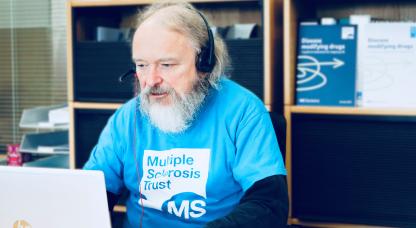At the moment, there is no cure for multiple sclerosis.
Current treatment is based on controlling disease activity by reducing the number of relapses someone experiences, or by managing the individual symptoms of MS.
However, we are closer than ever to the point where we can bring MS under control, delaying the onset and progression of disability, and living more years relapse-free or symptom-free. Part of this improvement comes from new drug treatments that tackle the underlying processes driving MS in the body. Part comes from our understanding of how lifestyle and self-management can allow people with MS can live healthier lives for longer, and with less impairment, although this is not a cure for MS.
Some of the current highly effective treatments for RRMS may, after long term follow-up, show something close to a cure for MS for some people. It is too early to say for sure yet, and it depends how we would define a cure.
There is still a long way to go. People with progressive MS have fewer treatment options and are still likely to experience considerable disability.
At a global level, curing MS may mean removing the complex causes of MS, and making sure that people at risk know how to reduce their chances of developing MS. Some neuroscientists think that reducing Epstein-Barr virus infections, reducing smoking and obesity, and ensuring adequate vitamin D could reduce MS prevalence.
At an individual level, once a person has MS, what would a cure look like? There are a series of goals aim for:
- Reduction in rate of deterioration - Current therapies aim to slow down the rate of disease progression and delay the accumulation of disability.
- Stabilisation - Some current therapies appear to be able to stabilise a persons' level of disability. They may not get better, but they also don't get worse, at least for a while.
- Improvement - A clear goal is to be able to improve the health and abilities of a person with MS back to an age-appropriate normal level.
- Recovered function - A goal for the far future might be to remove all deterioration, from ageing as well as MS, and get the nervous system back to a near-perfect state.
Everyone, whether they have MS or not, accumulates nerve damage with age. In MS, inflammation causes nerve damage which may be hidden in the early stages of the condition, only showing later as stressed neurons eventually die off and permanent damage is caused. This combination of normal age-related deterioration and the time-bomb effect of nerve damage means that it is harder to identify effective treatments or a cure in older people who have had MS for several years. Cognitive reserve.
For people with RRMS, the treatment goal of NEDA (no evidence of disease activity) implies an aim of no relapses and no deterioration. For people with SPMS and PPMS, the goal is NEPAD (no evidence of progression or active disease), where the implications are that there is no progression and no deterioration. If you were living with no evidence of active MS, how long would you wait until you would consider yourself 'cured'?
Remission may be a more useful term than cure. Perhaps after several years with NEDA, you could consider yourself in remission from MS. Some people on effective treatment regimes have been in a NEDA status for over a decade now. Although they might still experience relapses and progression in the future, in the meantime their MS does not affect them. As you might imagine, this is a very debatable topic.
There are currently three main focuses of research that offer hope in finding treatments that may alter the course of multiple sclerosis and eventually provide a cure.
- Immune system - altering or halting the processes that cause damage to nerves. In this area there are already a number of licensed disease modifying drugs with others in development. Existing treatments in this category include immune modulating drugs, and immune reconstruction therapy, with treatments like alemtuzumab or AHSCT to wipe out the existing immune system and replace it with a healthy one.
- Neuroprotection - protecting nerves to prevent any further damage, whether inflammation is present or not. Research in this category is focused around new and existing drugs that may have a protective effect on the nerves and myelin. It is also looking at treatments to keep glial cells healthy and encourage them to make new myelin.
- Repair - repairing or replacing damaged nerve cells to reverse disabilities. Research in this area is looking at the potential of stem cells to see if they can be turned into replacement neurons.


